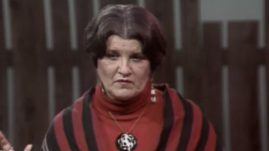Teachers' Domain - Digital Media for the Classroom and Professional Development
User: Preview



Marilou Awiakta, of Cherokee/Appalachian heritage, tells a traditional Cherokee story in which humans are killing too many of their animal relatives, threatening the delicate balance of nature. Little Deer leads the animals in taking action, teaching the lesson that people should take “only what you need with respect and gratitude.”
This resource is part of the Native American Culture collection.
Find additional arts resources for your classroom at the KET Arts Toolkit website.
Native American Culture: Cherokee People and Their Stories Lesson Plan (Document)
Awi Usdi (or “Little Deer”), a Cherokee spirit of respect, circles through time to teach the principle of “taking only what you need with respect and gratitude.” The first English version of this traditional Cherokee tale appeared in Myths of the Cherokee and Sacred Formulas of the Cherokee by James Mooney, an ethnologist from the Smithsonian Institution. He was told the story in 1887 by Swimmer of the Eastern Cherokee in N.C., who was a shaman, or tribal holy man, and repository of the tribe’s collected wisdom.
The interconnectedness of all things is a deeply held Native American belief. The world is connected in a Sacred Circle or a web of life; each strand represents rocks, trees, animals, water, air, fish, plants, humans, etc., and when one strand is broken, all are affected. Stories are part of this web of life. They play a vital function in Native American culture. They entertain, instruct, and empower all at once. They are not subdivided, as Western oral stories are, into legends, myths, or folktales; nor are they strictly parables or fables designed to teach specific morals.
The idea of Little Deer as a living presence provides an excellent opportunity to dispel the myth that American Indians have “vanished.” Little Deer is 2,500 years old, as old as the Cherokee themselves. They still tell his story, both in the eastern band in North Carolina, which has about 9,000 members, and in the Cherokee Nation of Oklahoma, which numbers more than 100,000. The Cherokee, in fact, are the second largest tribe in America.
Another important aspect of the story is the traditional attitude toward animals that it reflects. Stories like “Little Deer and Mother Earth” are not “animal stories,” in which animals speak like people or somehow symbolize people. Rather, the animals themselves are seen as “family,” relatives who are equal partners with humans on earth. They speak for themselves about the wisdom of respect and cooperation, and their points of view must be taken into account.
 Loading Standards
Loading Standards